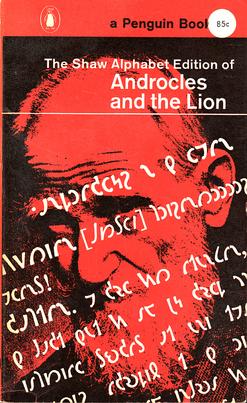
Eth, known as ðæt in Old English, is a letter used in Old English, Middle English, Icelandic, Faroese, and Elfdalian.

The Shavian alphabet is a constructed alphabet conceived as a way to provide simple, phonemic orthography for the English language to replace the inefficiencies and difficulties of conventional spelling using the Latin alphabet. It was posthumously funded by and named after Irish playwright Bernard Shaw.
Although people in many parts of the world share common alphabets and numeral systems, styles of handwritten letterforms vary between individuals, and sometimes also vary systematically between regions.

Shorthand is an abbreviated symbolic writing method that increases speed and brevity of writing as compared to longhand, a more common method of writing a language. The process of writing in shorthand is called stenography, from the Greek stenos (narrow) and graphein. It has also been called brachygraphy, from Greek brachys (short), and tachygraphy, from Greek tachys, depending on whether compression or speed of writing is the goal.
Dutton Speedwords, transcribed in Speedwords as Dutton Motez, is an international auxiliary language as well as an abbreviated writing system using the English alphabet for all the languages of the world. It was devised by Reginald J. G. Dutton (1886–1970) who initially ran a shorthand college promoting Dutton Shorthand, then offered a mail order (correspondence) self-education course in Speedwords while still supporting the Dutton Shorthand. The business was continued by his daughter Elizabeth after his death.
Pitman shorthand is a system of shorthand for the English language developed by Englishman Sir Isaac Pitman (1813–1897), who first presented it in 1837. Like most systems of shorthand, it is a phonetic system; the symbols do not represent letters, but rather sounds, and words are, for the most part, written as they are spoken.

A steno machine, stenotype machine, shorthand machine, stenograph or steno writer is a specialized chorded keyboard or typewriter used by stenographers for shorthand use. In order to pass the United States Registered Professional Reporter test, a trained court reporter or closed captioner must write speeds of approximately 180, 200, and 225 words per minute (wpm) at very high accuracy in the categories of literary, jury charge, and testimony, respectively. Some stenographers can reach 300 words per minute. The website of the California Official Court Reporters Association (COCRA) gives the official record for American English as 375 wpm.
The numero sign or numero symbol, №, (also represented as Nº, No̱, No. or no.), is a typographic abbreviation of the word number(s) indicating ordinal numeration, especially in names and titles. For example, using the numero sign, the written long-form of the address "Number 22 Acacia Avenue" is shortened to "№ 22 Acacia Ave", yet both forms are spoken long.

Letter case is the distinction between the letters that are in larger uppercase or capitals and smaller lowercase in the written representation of certain languages. The writing systems that distinguish between the upper- and lowercase have two parallel sets of letters: each in the majuscule set has a counterpart in the minuscule set. Some counterpart letters have the same shape, and differ only in size, but for others the shapes are different. The two case variants are alternative representations of the same letter: they have the same name and pronunciation and are typically treated identically when sorting in alphabetical order.

Gregg shorthand is a system of shorthand developed by John Robert Gregg in 1888. Distinguished by its phonemic basis, the system prioritizes the sounds of speech over traditional English spelling, enabling rapid writing by employing elliptical figures and lines that bisect them. Gregg shorthand's design facilitates smooth, cursive strokes without the angular outlines characteristic of earlier systems like Duployan shorthand, thereby enhancing writing speed and legibility.
Words per minute, commonly abbreviated wpm, is a measure of words processed in a minute, often used as a measurement of the speed of typing, reading or Morse code sending and receiving.

Teeline is a shorthand system developed in 1968 by James Hill, a teacher of Pitman Shorthand. It is accepted by the National Council for the Training of Journalists, which certifies the training of journalists in the United Kingdom.
Personal Shorthand, originally known as Briefhand in the 1950s, is a completely alphabetic shorthand.
Dž is the seventh letter of the Gaj's Latin alphabet for Serbo-Croatian, after D and before Đ. It is pronounced. Dž is a digraph that corresponds to the letter Dzhe (Џ/џ) of the Serbian Cyrillic alphabet. It is also the tenth letter of the Slovak alphabet. Although several other languages also use the letter combination DŽ, they treat it as a pair of the letters D and Ž, not as a single distinct letter.
Thomas Natural Shorthand is an English shorthand system created by Charles A. Thomas which was first published in 1935. Thomas described his system as "designed to meet the existing need for a simple, legible shorthand that is based on already familiar writing lines, and that is written with a minimum number of rules." The system has fallen into disuse with the decline of pen shorthand in the later 20th century, but the spirit of the system lives on in Teeline shorthand, with which it shares a number of characteristics.

Đ, known as crossed D or dyet, is a letter formed from the base character D/d overlaid with a crossbar. Crossing was used to create eth (ð), but eth has an uncial as its base whereas đ is based on the straight-backed roman d, like in Sámi Languages and Vietnamese. Crossed d is a letter in the alphabets of several languages and is used in linguistics as a voiced dental fricative.

A tactile alphabet is a system for writing material that the blind can read by touch. While currently the Braille system is the most popular and some materials have been prepared in Moon type, historically, many other tactile alphabets have existed:
Forkner Shorthand is an alphabetic shorthand created by Hamden L. Forkner and first published in 1955. Its popularity grew through the 1980s as those who needed shorthand every day began to favor the easier learning curve of alphabetic systems to the more difficult symbol-based ones. Forkner was taught in high-schools and colleges throughout North America along with comparable shorthands such as AlphaHand, Speedwriting, Stenoscript and Personal Shorthand.
Simson Shorthand is a system of shorthand invented by James Simson, originally published in his 1881 book, Compend of Syllabic Shorthand: Being a Synopsis of the System, and in more detail in his books, Syllabic Shorthand (1883). At least three versions of the latter were published; the third edition being published in 1885 under the title Manual of Syllabic Shorthand.












